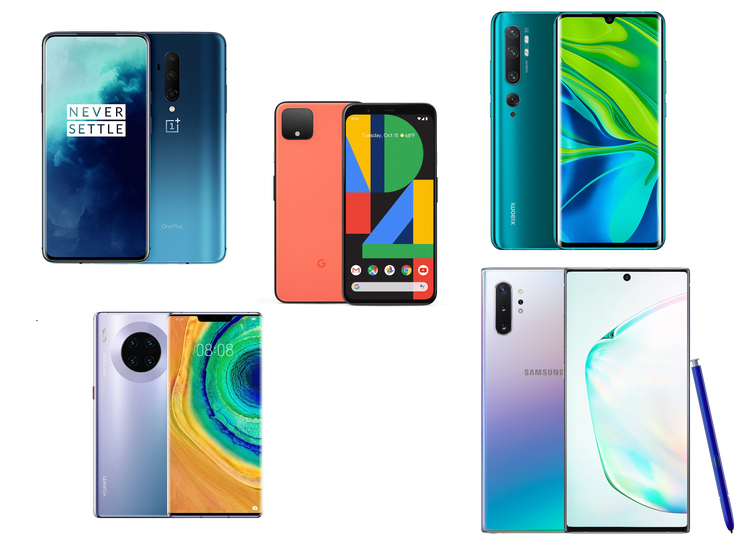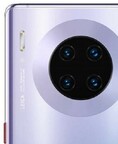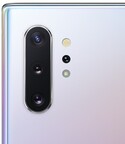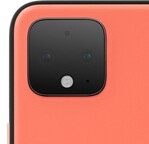High-End Smartphone Camera Comparison: DxOMark for smartphones is just not relevant for everyday life
Following on from our camera comparison test earlier this year, we have decided to subject the current Android smartphone elite to a detailed set of camera tests. In particular, the short-lived DxOMark champion, the Mi Note 10, would like to set new standards in smartphone photography with the Samsung Bright HMX, a 108 MP camera Xiaomi has also included in the Mi CC9 Pro.
We will take a closer look at whether Xiaomi has succeeded in including such a high-resolution camera in its latest flagship and who of the current Android elite can deliver the best overall package. We shall assess this in terms of camera quality using various scenarios and lighting situations. But first, an overview of what our comparison devices have to offer.
Camera Hardware Comparison
Starting with Xiaomi's latest flagship, the Mi Note 10 has five rear-facing cameras. Its main sensor, the Bright HMX, has 108 MP as we mentioned earlier along with an f/1.69 aperture. There are also two telephoto lenses, one 5 MP and the other 12 MP, that support 5x and 2x optical zoom respectively. Additionally, there is a 2 MP macro sensor and a 20 MP ultra-wide-angle camera that has an f/2.2 aperture.
By contrast, the OnePlus 7T Pro, like its predecessor, uses the Sony IMX586 as its main rear-facing camera. The 48 MP sensor has an f/1.6 aperture, which OnePlus complements with a 16 MP ultra-wide-angle lens, along with an 8 MP telephoto sensor that supports 3x optical zoom.
Meanwhile, the Mate 30 Pro has four rear-facing cameras, although its 3D depth-sensing camera cannot be used in its own right. Its main and ultra-wide cameras are both 40 MP sensors, while its 8 MP telephoto lens supports 3x optical zoom and up to 5x hybrid zoom. Its 40 MP main sensor also has an f/1.6 aperture.
By contrast, the Galaxy Note 10+, like the Galaxy S10 series, has a 12 MP main camera. The sensor has comparatively large pixels, along with dual pixel autofocus and an f/1.5-f/2.4 variable aperture. Like the competition, the Galaxy Note 10+ also has ultra-wide-angle and telephoto sensors, which can shoot in up to 16 MP and 12 MP, respectively. The latter also Pixel 4supports up to 2x optical zoom. Last but not least is a VGA 3D depth camera sensor.
Finally, we have the Pixel 4, which has a comparatively simple camera setup. Google has only included two sensors, a 12 MP main camera with an f/1.7 aperture, and a 16 MP telephoto lens. This is one more than its predecessor has, and while the telephoto lens offers 2x optical zoom, it has a comparatively narrow aperture of f/2.4.
| Xiaomi Mi Note 10 | Google Pixel 4 | OnePlus 7T Pro | Samsung Galaxy Note 10 + | Huawei Mate 30 Pro | |
|---|---|---|---|---|---|
| Rear-facing cameras | Camera 1: 108 MP, f/1.69, Samsung HMXCamera 2: 12 MP, f/2.0Camera 3: 20 MP, f/2.2Camera 4: 5 MP, f/2.0Camera 5: 2 MP, f/1.75 | Camera 1: 12.2 MP, Dual-Pixel-Phase-AF, OIS, EIS, f/1.7Camera 2: 16 MP, 1.0 μm, Phase-AF, OIS, EIS, f/2.4 | Camera 1: 48 MP Sony IMX586, 1.6 μm, f/1.6, OISCamera 2: 8 MP Tele, 1 μm, OIS, f/2.4Camera 3: 16 MP ultra-wide-angle, f/2.2Triple-Autofocus: PDAF, Laser, Contrast | Camera 1: 12 MP f/1.5-f/2.4, Phase comparison-AF (Dual-Pixel), OISCamera 2: 12.0 MP, f/2.1, Phase comparison-AF, OIS, TelephotoCamera 3: 16.0 MP, f/2.2, ultra-wide-angle | Camera 1: 40 MP, f/1.6, OISCamera 2: 40 MP ultra-wide-angle f/1.8Camera 3: 8 MP telephoto, f/2.4 |
| Front-facing cameras | 32 MP, f/2.0, 1.6 μm, 4-in-1 super pixel | 8 MP, 1.22 μm, f/2.0, Fixed focus | 16 MP Sony IMX471, 1 μm, f/2.0, fixed focus, EIS, retractable | 10 MP f/2.2, Phase comparison-AF (Dual-Pixel) | 32 MP, f/2.0, fixed focus |
| Software version | 11.0.11 | 190821.014 | 10.0.4 | N975FXXS1ASKB | 10.0.0.161 |
Rear-Facing Cameras: Test Conditions
We shall test all the smartphones in this comparison with their cameras set to pixel binning mode where possible. If you are unfamiliar with pixel binning, then the sensor combines at least 2x2 adjacent pixels to form one large pixel. This reduces the resolutions of the Mi Note 10 to 27 MP, the OnePlus 7T Pro to 12 MP and the Mate 30 Pro to 10 MP, for reference.
We also used AI during our camera comparisons. We left camera settings at factory defaults, though.
Daylight Photography
Even in good lighting conditions, differences in the focus and colour management are noticeable. The Mi Note 10 often lacks sharpness compared to the competition, for instance, while its exposure is often not optimal either, making pictures taken with the 108 MP sensor appear overexposed. Due to the somewhat overly warm colour rendering and reduced details, the OnePlus 7T Pro performs on a similar level to Xiaomi's latest flagship.
Analogous to our last camera comparison, the colour accuracy and, to some extent, the dynamic range of the Mate 30 Pro disappoint. Green tones look unnatural, for example, which is something that also applies to the Galaxy Note 10+. The latter has better dynamic range and colour accuracy than the former, though. Again, the Galaxy Note 10+ tends to reproduce colours too warmly for our liking.
Overall, we prefer daylight shots of the Pixel 4 to those of our other comparison devices. While they look natural, the Pixel 4 preserves contrasts well too. However, the device suffers from some image sharpness issues as our other comparison devices do too.
A similar picture appears in portrait mode. While the Pixel 4 reproduces contrasts richly and blurs background imagery well, our comparison devices also create decent bokeh effects. The additional depth of field optics help in this regard.
Switching to the telephoto lenses results in visibly lower image quality. The 3x zoom range is disappointing in all smartphones compared to the main rear-facing camera, although the OnePlus 7T Pro convinced us best here. Incidentally, there is a slight red tinge to the photos taken with the Mate 30 Pro.
The photo quality of the Mi Note 10 is surprisingly good when using its 5x zoom, though. The colours are realistic too, and photos look noticeably sharper than our other comparison devices. A glance outside the centre of the picture reveals visible weaknesses in the sharpness that the OnePlus 7T Pro can capture, something that also applies to the Galaxy Note 10+, but slightly less pronounced. The Pixel 4 also struggles, despite its sophisticated software, with objects looking comparatively blurry and lacking in detail. The Pixel 4 and Galaxy Note 10+ have a technical disadvantage here because of their native 2x optical zoom cameras.
Since the Pixel 4 lacks an ultra-wide-angle camera, we have not included it in this section. Separately, the Galaxy Note 10+ has excellent colour accuracy here, with it being able to pick out details and dynamics well too. However, we should point out that sharpness levels drop off at the edge of images. The Mi Note 10 and Mate 30 Pro fare much better in this regard. The OnePlus 7T Pro impressed us with the number of details that it captured too, but it reproduces colours too warmly for our liking. The latter applies to the Mate 30 Pro too.
Low-light Photography
Overall, the low-light capabilities of the Mate 30 Pro leave its competitors in the dust. The gap between Huawei and other OEMs has shrunk significantly though because the Mate 30 Pro also has some focusing issues. There are some image errors too, such as the bright stripes shown in the first test shots below. The Galaxy Note 10+ suffers from the same issue, though. In short, low-light shots look murkier and are more washed-out on the Galaxy Note 10+ compared to those taken with the Mate 30 Pro. The former does a better job at matching colours, in our opinion.
The new Samsung image sensor in the Mi Note 10 reaches its limits in low-light, despite its use of pixel binning. Its image sharpness is hardly convincing either, even in our fairly well-lit street scene.
The Mate 30 Pro remains top of the class even when we take night mode into consideration. If you are unfamiliar with night mode, then it takes several shots and combines them to form the best possible image. The Mate 30 Pro excels with the accuracy of its exposure levels here. However, the Pixel 4 uses its Night Sight mode to great effect here, with it being able to pick out more details and better expose a scene than it can using the automatic mode.
Zoom shots in low-light show the clearest differences between our comparison devices. The Mi Note 10 and Mate 30 Pro are in a different league here thanks to their 5x optical zoom sensors. The Mi Note 10 sets itself apart from the Mate 30 Pro too though, as it can capture scenes more sharply than Huawei's latest flagship can. The Pixel 4, on the other hand, cannot capture as many details as these two can, while there is noticeable image noise in our test shots. The Galaxy Note 10+ also struggles here, with our test shots dominated by blur. The blur is so bad that it is difficult to tell objects apart from each other. Dark areas are particularly noisy, while the structures of surfaces are barely visible.
The Mate 30 Pro has the least noisy ultra-wide-angle shots here, with its corresponding sensor capturing a relatively large amount of light while also maintaining image details quite well. The device has decent colour management too. Conversely, the Mi Note 10 struggles to pick out as many details as the Mate 30 Pro can, with image noise also being considerably more pronounced. Likewise, the Mi Note 10 could do a better job of exposing low-light scenes. The Galaxy Note 10+ does a much better job in this regard, but it cannot compete with the image quality that the Mate 30 Pro offers.
Front-Facing Camera Results
Even in plenty of light, sharpness levels, dynamic range and colour accuracy all vary widely between our comparison devices. The Galaxy Note 10+, for instance, captures objects relatively softly, but its exposure levels and details that it picks out are more convincing. The same applies to the Pixel 4, although it delivers better contrasts and more natural colours than the Galaxy Note 10+ can. The OnePlus 7T Pro matches the Galaxy Note 10+ in this respect, in our opinion. Qualitative differences between the Mate 30 Pro and Mi Note 10 are much more striking, though. Our test shots look more overexposed and have less contrast than our comparison devices, while the two devices capture fewer details too.
These differences become even clearer in difficult lighting conditions, as demonstrated by the second set of images below. Visible blurring and artefacts are even noticeable in shots taken with the Pixel 4, but Google's software still gets the best dynamics and contrasts in low-light situations than our other comparison devices can. In comparison, those shot with the Mi Note 10 look particularly overexposed.
Verdict - 108 MP alone is not enough to make the top of the class
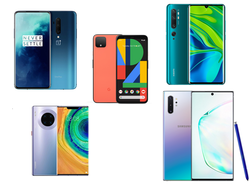
Once again, this camera comparison shows that the overall score from DxOMark alone is not really a meaningful result in relation to the photo quality of smartphones. In short, the overall score benefits the smartphone manufacturers and their marketing campaigns more than it reflects camera quality in everyday use. The Mi Note 10 is an example of this. Until recently, the device was top of DxOMark's overall leaderboard thanks to its 108 MP Samsung HMX main camera. However, the Pixel 4, which DxOMark scored noticeably less overall, clearly outperforms the Mi Note 10 in some areas. Likewise, the Pixel 4 convinced us most in our front-facing camera tests, again contrary to DxOMark's score.
The Pixel 4 can also get the most from its 12 MP main camera, especially in daylight. By contrast, Mi Note 10 cannot optimally balance sharpness and exposure levels using its 108 MP sensor. From our point of view, the Galaxy Note 10+ also offers a better dynamic range and captures more details than the Mi Note 10. The Galaxy Note 10+ also reproduces nicer contrasts than the Mi Note 10 can, even if Samsung's colour management tends to be a little too warm for our liking. The Mate 30 Pro struggles in some areas too, especially colour accuracy. This is true with the P30 Pro too, so evidently Huawei cannot convert its impressive hardware into equally impressive daylight photos. In short, Huawei needs to optimise its camera app in our opinion, because the P30 Pro and Mate 30 Pro both have first-class cameras on paper.
Overall, Xiaomi's current software holds the Samsung HMX 108 MP sensor back from spearheading the smartphone camera sector.
Huawei does make up ground in low-light shots, though. Its ultra-wide-angle optics are a class above our comparison devices, for example, although the competition now retain more details and does a better job at exposing scenes than they did previously. We also preferred the photo quality of the Mi Note 10's 5x optical telephoto lens to that of Huawei's current flagship.




